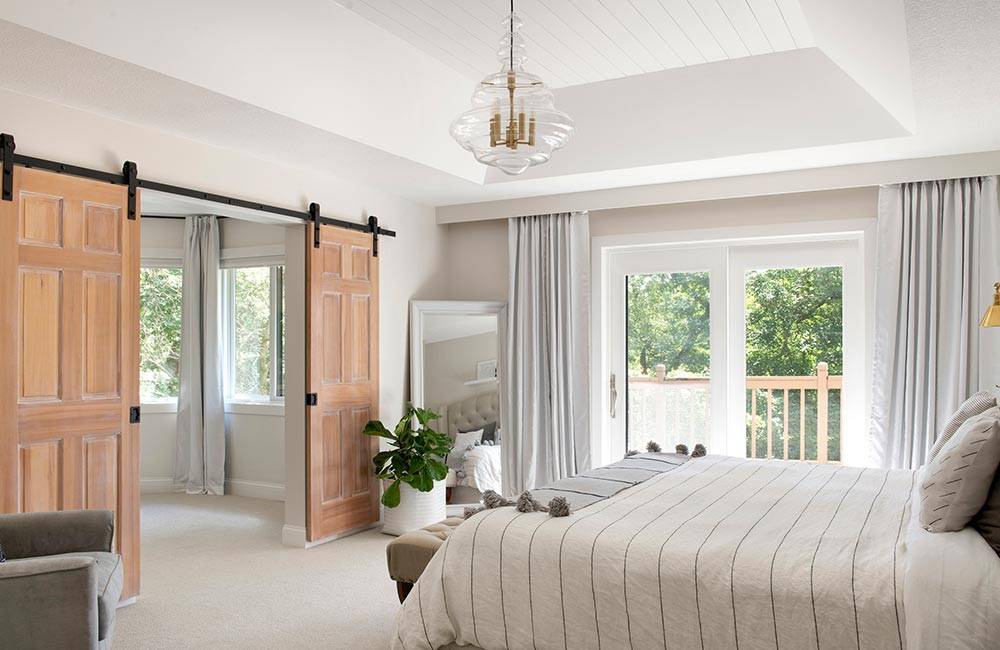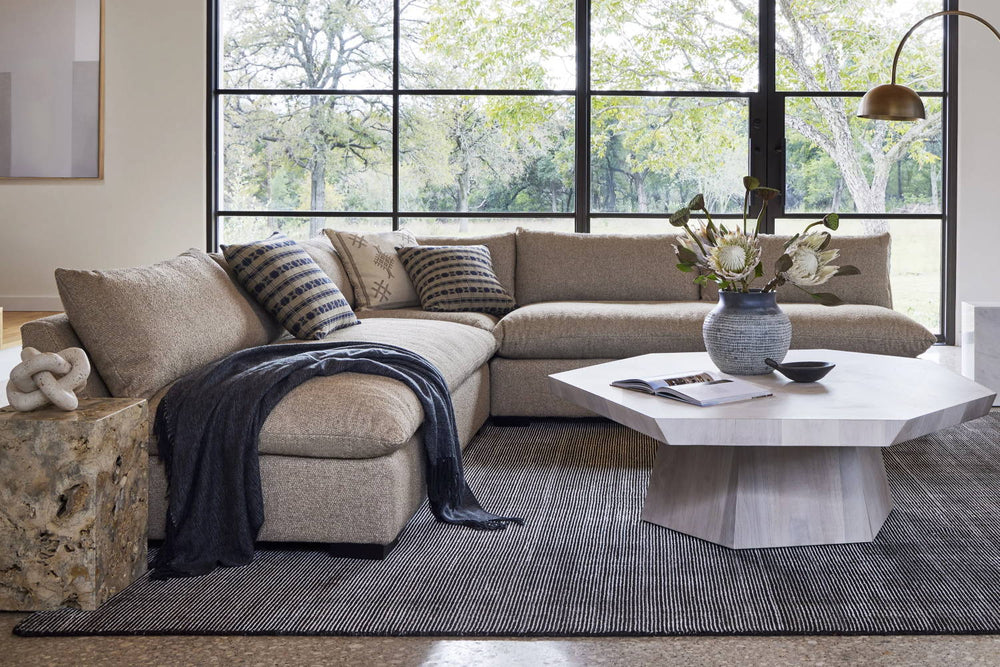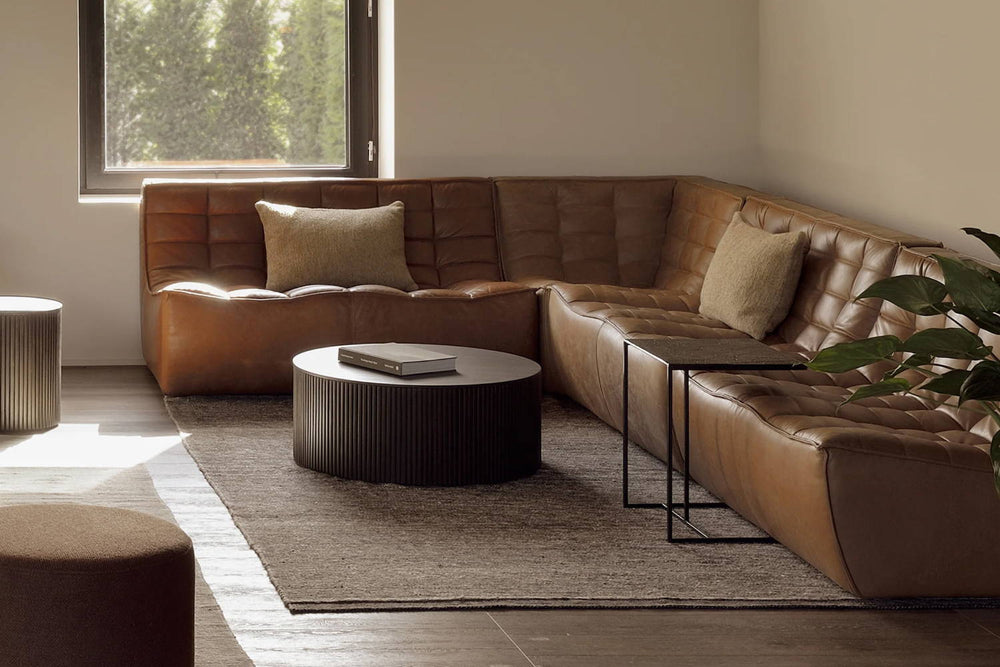Focus on these key factors when selecting a living room couch.
1. Size and proportion are crucial.
This may seem like an obvious point, but one of the most common mistakes made when purchasing a new sofa is selecting the wrong size. As with all furniture, size and proportion can be the difference between a well designed interior and an awkwardly composed one. So, making precise measurements of your room should be your first step towards finding a couch that best fits its chosen space. In addition to measuring the room, consider the size and proportion of the other seating in your space. If you have a lounge chair, ottoman, or other seating options, they'll need to work in concert with the sofa, ultimately informing the sofa size you finally settle on. Before any purchase, then, measuring is the crucial first step.
SHOP THE LOOK
AVERAGE SOFA MEASUREMENTS
Sofa Length
- 60-72 inches Seats 2
- 84-90 inches Seats 3
- 90+ inches Seats 4
Sofa Depth
- 25+ inches Deep
- 23-24 inches Average
- 21-22 inches Shallow
Sofa Height
- 22+ inches High
- 20-21 inches Average
- 18-19 inches Low
2. Shape makes a difference.
As with size, shape will also determine the overall usability and attractiveness of you living space. Is a standard sofa the best option, or is an L-shaped sectional more practical for your lifestyle? Does an angular shape complement the room's elements, or is there enough room for a rounded, organically shaped sofa? A minimal, low-profile sofa may be the perfect solution, or a sumptuously upholstered couch may be the ideal counterpoint to other minimalist furnishings. Just as it's essential for gauging size, measuring your room or space properly will also give you key information about which sofa shape can be best accommodated by the square footage you're working with—and will will help avert common mistakes.
HOW TO MEASURE A ROOM FOR A SOFA
As with all primary furniture purchases, measuring is imperative. For a sofa purchase, it's essential that you measure room/space, sofa dimensions, and the access points in your house: doors, hallways, stairwell. The following is a basic guide to accurate measuring prior to making a purchase.
MEASURE YOUR ROOM OR SPACE FIRST
It may be tempting to just eyeball your room's size, but don't be fooled by your eye. Get out that measuring tape and write down the fundamentals: width, length, and height of the room. The length and width of your room is obvious, but the height of your ceiling also plays a roll in achieving the right proportion of furniture for the space. Once the basic dimensions are arrived at, hone in on the area of the room where you plan to place your sofa. Consider the other pieces of furniture that will be occupying the same general area, and arrive at the length, height, and sofa depth that the space will comfortably accommodate.
MEASURE HALLWAYS, DOORS, STAIRS
Nothing will be more frustrating than finding your perfect sofa, only to discover that an access point—front door, stairwell, hallway—are too small to accommodate it. Avoid this common mistake and measure all the areas through which your sofa will need to travel upon arrival. Use a measuring tape, and measure the height, length or width of any hallways and doors, entryway to house or apartment building, as well as elevator height and width. Be sure to take note of any other obstacles, like banisters, ceiling fixtures, or wall protrusions, that may also present problems when moving furniture in and out.
MATCH SOFA DIMENSIONS TO ROOM SIZE
Once you've measured you room and entry access points, you can more accurately gauge your desired sofa against the dimensions your space.The length and depth of your sofa (sans removable cushions) should safely clear the width of any hallway or door through which the sofa will travel. If the sofa is delivered via elevator, the sofa's length (height, if turned vertically), should safely clear the height of a elevator's ceiling. Note that to measure the diagonal depth of the sofa, place a straight edge from the highest point of the back frame (without cushions) to the front of the sofa arm. Then, using your measuring tape, measure from the bottom rear corner of the sofa up to the point that bisects the straight edge.
3. Upholstery and fabric are major players.
How you plan to use your sofa—the projected wear and tear, in other words—will determine the kind of sofa upholstery or fabric choice that makes the most sense for your lifestyle. A fabric's durability, as well as how easy it is to clean, should be commensurate with the way your sofa is likely to used. A household with children and pets, versus a household with only adults and no pets, demands a different level of durability. Expensive fabric that won't hold up under the wear and tear of daily use, is never a good investment, no matter how visually pleasing. When choosing the ideal sofa, then, the sofa's primary function should always be the driving force behind which sofa you ultimately select—down to fabric and cushioning.
SHOP THE LOOK
4. Personal style is everything.
Practical considerations are all well and good, but your living space should , more than anything, reflect your personal style and taste—elements that turn a generic space into a warm and inviting home. Selecting a comfortable and affordable sofa should certainly be guided by practical considerations, like size constraints and budget; but subjective aesthetic decisions involving an appealing shape, color, or decorative detail tend to connect us more closely to major purchases, like a couch. In other words, by all means, shop for your modern sofa with you heart as much as with your head.
SHOP THE LOOK








